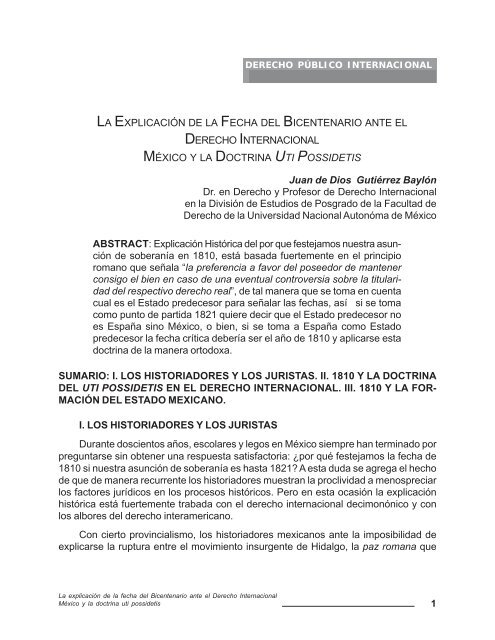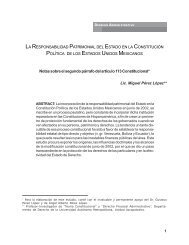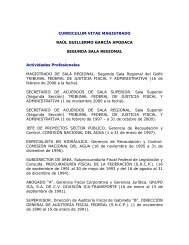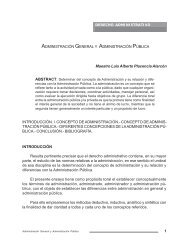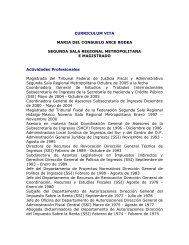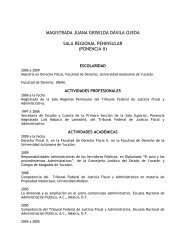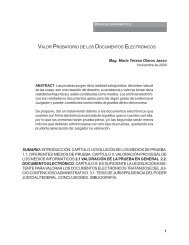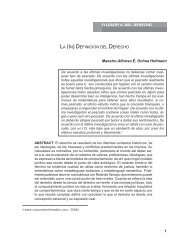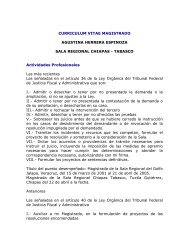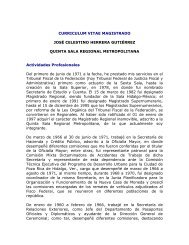descargar pdf - Tribunal Federal de Justicia Fiscal y Administrativa
descargar pdf - Tribunal Federal de Justicia Fiscal y Administrativa
descargar pdf - Tribunal Federal de Justicia Fiscal y Administrativa
Create successful ePaper yourself
Turn your PDF publications into a flip-book with our unique Google optimized e-Paper software.
LA EXPLICACIÓN DE LA FECHA DEL BICENTENARIO ANTE EL<br />
DERECHO INTERNACIONAL<br />
MÉXICO Y LA DOCTRINA UTI POSSIDETIS<br />
La explicación <strong>de</strong> la fecha <strong>de</strong>l Bicentenario ante el Derecho Internacional<br />
México y la doctrina uti possi<strong>de</strong>tis<br />
Juan <strong>de</strong> Dios Gutiérrez Baylón<br />
Dr. en Derecho y Profesor <strong>de</strong> Derecho Internacional<br />
en la División <strong>de</strong> Estudios <strong>de</strong> Posgrado <strong>de</strong> la Facultad <strong>de</strong><br />
Derecho <strong>de</strong> la Universidad Nacional Autonóma <strong>de</strong> México<br />
ABSTRACT: Explicación Histórica <strong>de</strong>l por que festejamos nuestra asunción<br />
<strong>de</strong> soberanía en 1810, está basada fuertemente en el principio<br />
romano que señala “la preferencia a favor <strong>de</strong>l poseedor <strong>de</strong> mantener<br />
consigo el bien en caso <strong>de</strong> una eventual controversia sobre la titularidad<br />
<strong>de</strong>l respectivo <strong>de</strong>recho real”, <strong>de</strong> tal manera que se toma en cuenta<br />
cual es el Estado pre<strong>de</strong>cesor para señalar las fechas, así si se toma<br />
como punto <strong>de</strong> partida 1821 quiere <strong>de</strong>cir que el Estado pre<strong>de</strong>cesor no<br />
es España sino México, o bien, si se toma a España como Estado<br />
pre<strong>de</strong>cesor la fecha crítica <strong>de</strong>bería ser el año <strong>de</strong> 1810 y aplicarse esta<br />
doctrina <strong>de</strong> la manera ortodoxa.<br />
SUMARIO: I. LOS HISTORIADORES Y LOS JURISTAS. II. 1810 Y LA DOCTRINA<br />
DEL UTI POSSIDETIS EN EL DERECHO INTERNACIONAL. III. 1810 Y LA FOR-<br />
MACIÓN DEL ESTADO MEXICANO.<br />
I. LOS HISTORIADORES Y LOS JURISTAS<br />
DERECHO PÚBLICO INTERNACIONAL<br />
Durante doscientos años, escolares y legos en México siempre han terminado por<br />
preguntarse sin obtener una respuesta satisfactoria: ¿por qué festejamos la fecha <strong>de</strong><br />
1810 si nuestra asunción <strong>de</strong> soberanía es hasta 1821? A esta duda se agrega el hecho<br />
<strong>de</strong> que <strong>de</strong> manera recurrente los historiadores muestran la proclividad a menospreciar<br />
los factores jurídicos en los procesos históricos. Pero en esta ocasión la explicación<br />
histórica está fuertemente trabada con el <strong>de</strong>recho internacional <strong>de</strong>cimonónico y con<br />
los albores <strong>de</strong>l <strong>de</strong>recho interamericano.<br />
Con cierto provincialismo, los historiadores mexicanos ante la imposibilidad <strong>de</strong><br />
explicarse la ruptura entre el movimiento insurgente <strong>de</strong> Hidalgo, la paz romana que<br />
1
sobrevino 1 y el proceso <strong>de</strong> consumación <strong>de</strong> 1821, se esfuerzan en vincularlos ya sea a<br />
la variabilidad <strong>de</strong> las capacida<strong>de</strong>s militares rebel<strong>de</strong>s, al retorno al po<strong>de</strong>r en España <strong>de</strong>l<br />
afrancesado Fernando VII, al Pronunciamiento <strong>de</strong> Riego o a una nueva cartografía <strong>de</strong><br />
po<strong>de</strong>r en el interior <strong>de</strong> la Nueva España, pero el hecho principal, el más contun<strong>de</strong>nte<br />
en las relaciones internacionales durante este interregno que lo es el nuevo equilibrio<br />
<strong>de</strong> po<strong>de</strong>res <strong>de</strong>terminados por el Congreso <strong>de</strong> Viena <strong>de</strong> 1815, ese sigue siendo puesto <strong>de</strong><br />
lado por los eruditos investigadores <strong>de</strong>l pasado. Tras el nuevo or<strong>de</strong>n vienés, la amenaza<br />
francesa queda <strong>de</strong>sarticulada al tiempo que la disminuida efectividad española en América<br />
y la <strong>de</strong>teriorada lealtad a su monarca hacen todavía más en<strong>de</strong>ble el vínculo colonial.<br />
El Congreso <strong>de</strong> Viena <strong>de</strong> 1815 se encuentra entre la i<strong>de</strong>alizada gesta <strong>de</strong> Dolores y el<br />
éxito <strong>de</strong>l movimiento Trigarante. Es la causa <strong>de</strong> este último y lo explica. Referirnos al<br />
movimiento <strong>de</strong> 1810 o al <strong>de</strong> 1808 o a cualquier otro acontecimiento coetáneo, 2 daría<br />
históricamente igual al no ser la causa eficiente <strong>de</strong> la conformación <strong>de</strong>l nuevo Estado<br />
nacional. 3 La consumación <strong>de</strong> la in<strong>de</strong>pen<strong>de</strong>ncia se vincula más a la puesta fuera <strong>de</strong>l<br />
<strong>de</strong>recho internacional <strong>de</strong> Napoleón y sus secuaces que al heroico periplo <strong>de</strong>l Padre <strong>de</strong> la<br />
Patria por el bajío mexicano. El interregno entre 1810 y 1821 es un trasunto <strong>de</strong>l Congreso<br />
<strong>de</strong> Viena <strong>de</strong> 1815. Entre Hidalgo e Iturbi<strong>de</strong> se yergue la Santa Alianza.<br />
El fenómeno <strong>de</strong>l largo proceso <strong>de</strong> insurgencia tiene <strong>de</strong>s<strong>de</strong> explicaciones etnoculturales 4<br />
hasta políticas. Privilegiar el relato <strong>de</strong>l episodio <strong>de</strong> insurgencia <strong>de</strong> don Miguel Hidalgo en<br />
1810 en <strong>de</strong>trimento <strong>de</strong>l alternativo que sería la entrada en 1821 <strong>de</strong>l Ejército Trigarante a la<br />
Ciudad <strong>de</strong> México, como fecha fundacional <strong>de</strong>l Estado nacional, tiene algunos alcances<br />
puramente i<strong>de</strong>ológicos. Sin embargo, lo cierto es que para el <strong>de</strong>recho internacional es que<br />
el punto <strong>de</strong> reconocimiento <strong>de</strong> la soberanía nacional lo es el año <strong>de</strong> 1810 y eso es una<br />
realidad. Si históricamente no lo fuese, jurídicamente sí. Lo que a los historiadores y a los<br />
profesores <strong>de</strong> educación primaria les resulta un rompecabezas insuperable, para los juristas<br />
es una más <strong>de</strong> nuestras construcciones con un sentido práctico palmario.<br />
1 Cfr. Alan Knight, Mexico. The Colonial Era, Cambridge University Press, 2002, p. 312.<br />
2 Como podría haberlo sido la Declaración <strong>de</strong> la In<strong>de</strong>pen<strong>de</strong>ncia <strong>de</strong> la América septentrional, dada en<br />
Chilpancingo el 6 <strong>de</strong> noviembre <strong>de</strong> 1813. (En don<strong>de</strong> por cierto, en la exposición <strong>de</strong> motivos <strong>de</strong>l Congreso<br />
Insurgente sobre la mencionada Declaración, se comienza invocando el mítico año <strong>de</strong> 1810).<br />
3 “En dépit <strong>de</strong> la défaite <strong>de</strong> l’Espagne métropolitaine et <strong>de</strong> sa ruine en 1808, et malgré la guerre civile<br />
qui ravagea la péninsule ibérique entre 1808 et 1814, l’Etat viceroyal ne s’effondra pas durant la<br />
pério<strong>de</strong> 1810-1820. “Brian R. Hamnett. Histoire du Mexique, Perrin, Paris 2009, p. 140.<br />
4 Cfr. Eric Van Young, La Otra Rebelión. La lucha por la in<strong>de</strong>pen<strong>de</strong>ncia <strong>de</strong> México, 1810-1821, FCE, México,<br />
2006, p. 869.<br />
2 Dr. Juan <strong>de</strong> Dios Gutiérrez Baylón
México como nuevo Estado nacional tuvo que adherirse a la ficción jurídica <strong>de</strong> la<br />
doctrina interamericana <strong>de</strong>l uti possi<strong>de</strong>tis, y con ello adoptar el año <strong>de</strong> 1810.<br />
II. 1810 Y LA DOCTRINA DEL UTI POSSIDETIS EN EL DERECHO INTERNACIONAL<br />
En pocas ocasiones en las investigaciones historiográficas <strong>de</strong> los Estados latinoamericanos<br />
se ha profundizado suficientemente en torno a la persistente fijación <strong>de</strong>l año<br />
<strong>de</strong> 1810 como punto <strong>de</strong> partida <strong>de</strong>l nacimiento <strong>de</strong> dichos Estados nacionales, pese al<br />
hecho <strong>de</strong> que tales miembros <strong>de</strong> la comunidad internacional lograron eficazmente<br />
dicha categoría en la mayor <strong>de</strong> las veces hasta una década <strong>de</strong>spués. Lo anterior se<br />
<strong>de</strong>be a un problema propio <strong>de</strong>l <strong>de</strong>recho internacional, específicamente originario <strong>de</strong>l<br />
<strong>de</strong>recho interamericano. El caso <strong>de</strong> la formación <strong>de</strong>l Estado mexicano es paradigmático<br />
respecto <strong>de</strong>l fenómeno arriba <strong>de</strong>scrito.<br />
La doctrina <strong>de</strong>l uti possi<strong>de</strong>tis se <strong>de</strong>sarrolló en el <strong>de</strong>recho internacional regional <strong>de</strong><br />
la América Latina como consecuencia <strong>de</strong> los problemas contenciosos territoriales que<br />
surgieron principalmente entre los Estados sucesores <strong>de</strong> España y Portugal en materia<br />
<strong>de</strong> <strong>de</strong>limitación fronteriza durante los albores <strong>de</strong>l siglo diecinueve y con proyección al<br />
5 En particular en el Africa subsahariana así como en la ex-Yugoslavia. En estas regiones la fórmula<br />
<strong>de</strong>l uti possi<strong>de</strong>tis ha sido en algunos casos irracionalmente extrapolada, dado que no se surte la<br />
hipótesis hispano lusitana <strong>de</strong> la existencia previa <strong>de</strong> fronteras internacionales que son heredadas a<br />
los Estados nacionales sucesores. En sentido similar véase: Steven R. Ratner, “Drawing a Better<br />
Line: Uti Possi<strong>de</strong>tis and the Bor<strong>de</strong>rs of New States,” American Journal of International Law, vol. 90, no.<br />
4, October 1996, pp. 590-624. Cfr. Delimitation of Maritime Boundary between Guinea-Bissau and Senegal,<br />
Decision of 31 July 1989, Reports of International Arbitral Awards, vol. XX, p. 146. En lo que concierne a<br />
América <strong>de</strong>l Sur, la doctrina uti possi<strong>de</strong>tis 1810 ha sido evocada varias veces en el siglo veinte. De esta<br />
suerte, en la controversia <strong>de</strong> fronteras entre Colombia y Venezuela, la doctrina es nuevamente explicada:<br />
“Ces territoires, bien que non occupés en fait, étaient d’un commun accord considérés comme<br />
occupés en droit, dès la première heure, par la nouvelle République. Des empiétements et <strong>de</strong>s tentatives<br />
<strong>de</strong> colonisation intempestives <strong>de</strong> l’autre côté <strong>de</strong> la frontière, comme aussi les occupations <strong>de</strong> fait,<br />
<strong>de</strong>venaient sans portée ou sans conséquences en droit. Ce principe avait aussi l’avantage <strong>de</strong> supprimer,<br />
on l’espérait, les contestations <strong>de</strong> limites entre les nouveaux États. Enfin, ce principe excluait les<br />
tentatives d’États colonisateurs européens sur <strong>de</strong>s territoires qu’ils auraient pu chercher à proclamer<br />
res nullius.” Affaire <strong>de</strong>s frontières Colombo-Vénézuéliennes, Sentence arbitrale du 24 mars 1922, Reports<br />
of International Arbitral Awards, Volume I, United Nations, p. 228. 10. As the Court un<strong>de</strong>rstands the<br />
matter, the doctrine has twomain aspects. First, all territory in Spanish-America, however remote or<br />
inhospitable, is <strong>de</strong>emed to have been part of one of the former administrative divisions of Spanish<br />
colonial rule (vice-royalties, captainciesgeneral, etc.). Hence there is no territory in Spanish-America<br />
that has the status of res nullius open to an acquisition of title by occupation. Secondly, the title to any<br />
given locality is <strong>de</strong>emed to have become automatically vested in whatever Spanish-American State<br />
inherited or took over the former Spanish administrative division in which the locality concerned was<br />
situated (uti possi<strong>de</strong>tis, ita possi<strong>de</strong>atis, —the full formula). Looked at in another way, uti possi<strong>de</strong>tis was<br />
a convenient method of establishing the boundaries of the young Spanish-American States on the<br />
same basis as those of the old Spanish administrative divisions, except that the latter were themselves<br />
often uncertain or ill<strong>de</strong>fined or, in the less accessible regions, not factually established at all, -or again<br />
un<strong>de</strong>rwent various changes.” Dispute between Argentina and Chile concerning the Beagle Channel, Decision<br />
of 18 February 1977, Reports of International Arbitral Awards, vol. XXI, pp. 81- 82.<br />
La explicación <strong>de</strong> la fecha <strong>de</strong>l Bicentenario ante el Derecho Internacional<br />
México y la doctrina uti possi<strong>de</strong>tis<br />
3
presente siglo en otras regiones <strong>de</strong>l mundo 5 , incluso la Corte Internacional <strong>de</strong> <strong>Justicia</strong><br />
(en sala) ha extrapolado la doctrina uti possi<strong>de</strong>tis juris 1961 en la <strong>de</strong>scolonización<br />
africana. 6<br />
La función <strong>de</strong> la doctrina en sus dos principales vertientes ha sido la <strong>de</strong> establecer<br />
<strong>de</strong> manera coherente los criterios <strong>de</strong> atribución <strong>de</strong> los espacios terrestres, ya sea en<br />
función a consi<strong>de</strong>raciones <strong>de</strong> efectividad en la posesión, como en su caso, a estimaciones<br />
cartográficas puramente formales.<br />
De acuerdo a los principios <strong>de</strong>l <strong>de</strong>recho intertemporal que dan sustento a las<br />
distintas posiciones en torno al uti possi<strong>de</strong>tis, la adjudicación <strong>de</strong> espacios terrestres<br />
en el <strong>de</strong>recho internacional <strong>de</strong>cimonónico permitía que ésta se realizara mediante las<br />
fórmulas <strong>de</strong>l <strong>de</strong>scubrimiento, la ocupación o la conquista. Son justamente estos medios<br />
<strong>de</strong> apropiación <strong>de</strong> los territorios internacionales lo que polarizó las posiciones entre los<br />
nuevos Estados <strong>de</strong> ascen<strong>de</strong>ncia hispánica, respecto al único pero muy importante<br />
Estado <strong>de</strong> origen lusitano en Sudamérica: el Brasil.<br />
Un repaso a los antece<strong>de</strong>ntes históricos que dan origen a la contienda nos permiten<br />
remontarnos a las famosas Bulas alejandrinas <strong>de</strong> Partición dictadas por el Papa<br />
Alejandro VI en al año <strong>de</strong> 1493, esto es, antes <strong>de</strong>l <strong>de</strong>scubrimiento mismo <strong>de</strong> los espacios<br />
continentales <strong>de</strong> lo que alguien bautizaría arbitrariamente como América. 7 De<br />
acuerdo con la doctrina, la <strong>de</strong>limitación borgiana se refería <strong>de</strong> manera exclusiva a la<br />
6 “The Chamber will first ascertain, by application of the principle of uti possi<strong>de</strong>tis juris, what the<br />
course of the intercolonial boundary was at the critical dates of in<strong>de</strong>pen<strong>de</strong>nce in August 1960. Only<br />
then is it required, if necessary, to consi<strong>de</strong>r the documents of 1973 and 1974 relied on by Benin in<br />
or<strong>de</strong>r to <strong>de</strong>termine whether they could validly have produced legal effects capable of affecting the<br />
course of the international boundary as previously <strong>de</strong>fined, that is to say the boundary resulting<br />
from the uti possi<strong>de</strong>tis of 1960.” Frontier Dispute (Benin/Niger), Judgment of July 12, 2005, I.C.J. Reports<br />
2005, parágrafo 127, p. 143. Ver también los parágrafos: 46, 71, 140 y 141.<br />
7 En este sentido son las conclusiones <strong>de</strong>l profesor Luis Weckmann: “Las Bulas alejandrinas <strong>de</strong> Partición,<br />
<strong>de</strong> 1493, constituyen una <strong>de</strong> las últimas aplicaciones prácticas <strong>de</strong> una vieja y extraña teoría<br />
jurídica, elaborada explícitamente en la corte pontificia a fines <strong>de</strong>l siglo XI, enunciada por primera vez<br />
en el año 1091 por el papa Urbano II (pero que quizá traza su paternidad a Gregorio VII) y conforme<br />
a la cual todas las islas pertenecen a la especial jurisdicción <strong>de</strong> San Pedro y <strong>de</strong> sus sucesores, los<br />
pontífices romanos, quienes pue<strong>de</strong>n libremente disponer <strong>de</strong> ellas. Esta teoría a la cual me referiré<br />
consistentemente bajo el nombre <strong>de</strong> doctrina omni-insular es, sin duda alguna, una <strong>de</strong> las elaboraciones<br />
más originales y curiosas <strong>de</strong>l <strong>de</strong>recho público medieval.” (Énfasis en el texto original).<br />
Constantino el Gran<strong>de</strong> y Cristóbal Colón. Estudio sobre la supremacía papal sobre islas, 1091-1493. FCE,<br />
México, 1992, p. 24.<br />
4 Dr. Juan <strong>de</strong> Dios Gutiérrez Baylón
atribución <strong>de</strong> las islas respecto <strong>de</strong> las cuales el vicario <strong>de</strong> Cristo guardaba un <strong>de</strong>recho<br />
real indiscutible según el <strong>de</strong>recho internacional medieval <strong>de</strong> conformidad con la doctrina<br />
omni insular. En este sentido <strong>de</strong>be quedar subrayadamente asentado que <strong>de</strong> conformidad<br />
con las faculta<strong>de</strong>s que contaba el Papa para emitir su resolución y dar fin al<br />
diferendo entre peninsulares, eran exclusivamente para la repartición <strong>de</strong> islas. 8 Para<br />
algunos las bulas <strong>de</strong> Alejandro VI tenían el carácter <strong>de</strong> laudo arbitral. 9<br />
Poco tiempo más tar<strong>de</strong>, (Tor<strong>de</strong>sillas 7 <strong>de</strong> junio <strong>de</strong> 1494), el propio Alejandro VI<br />
dictó una nueva bula con el fin <strong>de</strong> corregir y precisar la anterior, quedando así <strong>de</strong>finidos<br />
los espacios y las zonas <strong>de</strong> influencia <strong>de</strong> los dos principales Estados coloniales <strong>de</strong><br />
la región latinoamericana. Pero <strong>de</strong> manera paulatina se sentaron las bases <strong>de</strong>l conflicto<br />
fronterizo sudamericano y <strong>de</strong> manera concomitante las bases <strong>de</strong> la doctrina <strong>de</strong>l uti<br />
possi<strong>de</strong>tis con sus dos principales ramificaciones escolares: la doctrina uti possi<strong>de</strong>tis<br />
iuris o 1810 y la doctrina uti possi<strong>de</strong>tis <strong>de</strong> facto.<br />
8 En este sentido resulta lógico el hecho <strong>de</strong> que para el año <strong>de</strong> 1510 aproximadamente, el doctor<br />
Juan López <strong>de</strong> Palacios Rubios habla aún <strong>de</strong> “islas”: “Al tratar <strong>de</strong> las nuevas Islas, recientemente<br />
<strong>de</strong>scubiertas por Cristóbal Colón, parece necesario anticipar ciertas consi<strong>de</strong>raciones acerca <strong>de</strong> su<br />
situación, habitantes y costumbres, para que se tenga alguna noticia, <strong>de</strong> lo que, Dios mediante, me<br />
he propuesto tratar.” (Énfasis añadido) De las Islas <strong>de</strong>l mar Océano, FCE, México 1954, p. 6. En la<br />
jurispru<strong>de</strong>ncia internacional la doctrina uti possi<strong>de</strong>tis en materia insular aparece <strong>de</strong> manera temprana:<br />
“Considérant qu’à son tour le Vénézuéla fon<strong>de</strong> principalement son droit sur celui qu’avait l’Espagne<br />
avant la constitution <strong>de</strong> cette République comme État indépendant et que, s’il résulte bien que<br />
l’Espagne n’a pas matériellement occupé le territoire <strong>de</strong> l’île d’Aves, il est indubitable qu’il lui appartenait<br />
comme faisant partie <strong>de</strong>s In<strong>de</strong>s Occi<strong>de</strong>ntales qui étaient sous la domination [dominio] <strong>de</strong>s rois<br />
d’Espagne, conformément à la loi 1, titre V, livre I, <strong>de</strong> la Recopilación <strong>de</strong>s In<strong>de</strong>s.<br />
“Considérant que l’île d’Aves a dû faire partie du territoire compris dans le ressort du tribunal <strong>de</strong><br />
Caracas, lorsque ce tribunal fut créé le 13 juin 1786 et qu’en <strong>de</strong>venant nation indépendante, le<br />
Vénézuéla se constitua sur le territoire <strong>de</strong> la capitainerie générale du même nom, en déclarant,<br />
après coup, en vigueur dans le nouvel État toutes les dispositions adoptées par le gouvernement<br />
espagnol jusqu’en 1808, par quoi il put considérer l’île d’Aves comme partie <strong>de</strong> la province espagnole<br />
<strong>de</strong> Vénézuéla; (...)”. Sentence arbitrale relative à la question élevée entre le Vénézuéla et le Royaume<br />
<strong>de</strong>s Pays-Bas, <strong>de</strong> la domination et <strong>de</strong> la souverainété <strong>de</strong> l’île d’Aves, Décision du 30 juin 1865, Reports of<br />
International Arbitral Awards, vol. XXVIII, p. 122. Posteriormente: Cfr. Land, Island and Maritime Dispute<br />
(El Salvador/Honduras: Nicaragua intervening), Judgment of 11 September 1992, I.C.J. Reports 1992,<br />
pp. 558-559; Kasikili/Sedudu Island, (Botswana/Namibia), I.C.J. Judgment, 13 December 1999, Reports<br />
1999, para. 71-75.<br />
9 “El examen <strong>de</strong> los documentos comprueba que la sentencia arbitral no existió. Las bulas <strong>de</strong> Alejandro<br />
VI se expidieron sin conocimiento ni citación <strong>de</strong> los portugueses y el litigio entre las dos Coronas<br />
continuó mucho tiempo <strong>de</strong>spués <strong>de</strong> las bulas.” Silvio A. Zavala. Las instituciones jurídicas <strong>de</strong> la conquista<br />
<strong>de</strong> América, Porrúa, México 1971 p. 33.<br />
La explicación <strong>de</strong> la fecha <strong>de</strong>l Bicentenario ante el Derecho Internacional<br />
México y la doctrina uti possi<strong>de</strong>tis<br />
5
La línea <strong>de</strong> Tor<strong>de</strong>sillas o meridiano <strong>de</strong> <strong>de</strong>marcación ya contenía en su esquema <strong>de</strong><br />
<strong>de</strong>limitación un problema grave. Si el punto <strong>de</strong> referencia habría <strong>de</strong> serlo el ubicado a 370<br />
leguas marinas a partir <strong>de</strong> las islas <strong>de</strong> Cabo Ver<strong>de</strong>, cuál <strong>de</strong> todas ellas <strong>de</strong>bería consi<strong>de</strong>rarse<br />
el punto <strong>de</strong> partida. Cabo Ver<strong>de</strong> es un conjunto archipelágico bastante extendido, por lo<br />
que si se consi<strong>de</strong>ra la isla <strong>de</strong> San Antonio o en su caso la isla <strong>de</strong> San Nicolás, tendremos<br />
resultados <strong>de</strong> suyo distintos. Al margen <strong>de</strong> lo anterior, el meridiano <strong>de</strong> Tor<strong>de</strong>sillas <strong>de</strong>bería<br />
quedar situado aproximadamente entre los 48 º y los 50 º grados longitud oeste <strong>de</strong> París,<br />
como referencia correctora. En este or<strong>de</strong>n <strong>de</strong> i<strong>de</strong>as, cualquier in<strong>de</strong>finición en la línea <strong>de</strong><br />
<strong>de</strong>marcación se proyectaría en los espacios continentales (en principio insulares) lusohispanos,<br />
<strong>de</strong> tal manera que los Estados nacionales sucesores heredarían la polémica.<br />
Los tratados <strong>de</strong> Madrid <strong>de</strong>l 13 <strong>de</strong> enero <strong>de</strong> 1750 y <strong>de</strong> San Il<strong>de</strong>fonso <strong>de</strong> septiembre<br />
<strong>de</strong> 1777, (éste último sería uno <strong>de</strong> los apoyos <strong>de</strong> la doctrina uti possi<strong>de</strong>tis 1810),<br />
pretendieron infructuosamente <strong>de</strong>tener el avance portugués en la región. El Tratado <strong>de</strong><br />
San Il<strong>de</strong>fonso habría <strong>de</strong> servir <strong>de</strong> base <strong>de</strong> las reclamaciones <strong>de</strong> los sucesores <strong>de</strong><br />
España en la región latinoamericana.<br />
A) La doctrina uti possi<strong>de</strong>tis iuris o 1810<br />
10 En palabras <strong>de</strong>l propio Gayo: “148. Retinendae possesionis causa solet interdictum reddi, cum ab<br />
utraque parte <strong>de</strong> proprietate alicuius rei controuersia est, et ante quaeritur uter ex litigatoribus<br />
possi<strong>de</strong>re et uter petere <strong>de</strong>beat; cuius rei gratia conparata sun VTI POSSIDETIS et VTRVBI uero <strong>de</strong><br />
rerum mobilium possesione. 150 Nam et siqui<strong>de</strong>m <strong>de</strong> fundo uel aedibus intedicitur, eum potiorem<br />
esse praetor iubet qui eo tempore quo interdictum redditur nec ui nec clam nec precario ab aduersario<br />
possi<strong>de</strong>at; si uero <strong>de</strong> re mobili, eum potiorem esse iubet qui maiore parte eius anni nec ui nec clam<br />
nec precario ab aduersario possi<strong>de</strong>t; idque satis ipsis uerbis interdictorum significatur.”<br />
Y más a<strong>de</strong>lante el propio Gayo distingue: “160 Duplicia sunt ueluti VTI POSSIDETIS interdictum et<br />
VTRVBI. I<strong>de</strong>o autem duplicia uocantur quod par utriusque litigatoris in his condicio est nec quisquam<br />
praecipue reus uel actor intellegitur, sed unusquisque tam rei quam actoris partes sustinet; quippe<br />
praetor pari sermone cum utroque loquitur; nam summa conceptio eorum interdictorum haec est: vti<br />
nvnc possi<strong>de</strong>tis, qvominvs ita possi<strong>de</strong>atis vim fieri veto; item alterius: vtrvbi hic homo <strong>de</strong> qvo agitvr<br />
apvd qvem maiores partes hvivs anni fvit, qvominis is evm dvcat, vim fieri veto.”<br />
cfr. GAIUS, Institutes, Societé d’édition “Les belles lettres”, París 1979, páginas 176, 178 y 179.<br />
Fragmenta Vaticana, 90. Sobre sus alcances, cfr. Pacchioni, Giovanni, Manuale di Diritto Romano, Unione<br />
Tipografico-Editrice Torinese, Torino 1935, pp. 323-324; Monier, Raymond, Manuel élémentaire <strong>de</strong> droit<br />
romain, tome I, Éditions Domat Montchrestien, París 1947, p. 394; Talamanca, Mario, Istituzioni di<br />
Diritto Romano, Giuffrè Editore, Milano 1990, p. 497; Guarino, Antonio, Diritto Privato Romano, Editore<br />
Jovene Napoli, Dodicesima Edizione, Napoli, 2001, p. 509; Marrone, Mateo, Istituzioni di Diritto Romano,<br />
Palumbo, Palermo 2006, p. 385.<br />
6 Dr. Juan <strong>de</strong> Dios Gutiérrez Baylón
La doctrina objeto <strong>de</strong> nuestro estudio en el <strong>de</strong>recho internacional toma como<br />
referencia doctrinal la distinción que los jurisconsultos romanos 10 hicieran respecto <strong>de</strong><br />
la procedibilidad <strong>de</strong> sendos interdictos en materia <strong>de</strong> posesión, esto es, el uti utrubi<br />
(respecto <strong>de</strong> bienes muebles), así como <strong>de</strong>l uti possi<strong>de</strong>tis (para bienes inmuebles). En<br />
rigor, la institución jurídica internacional sólo recoge <strong>de</strong> su homóloga latina lo relativo a<br />
la preferencia a favor <strong>de</strong>l poseedor <strong>de</strong> mantener consigo el bien en caso <strong>de</strong> una<br />
eventual controversia sobre la titularidad <strong>de</strong>l respectivo <strong>de</strong>recho real. 11<br />
De acuerdo con los Estados sucesores <strong>de</strong> España en el continente americano 12 ,<br />
las nuevas fronteras internacionales <strong>de</strong>berían obe<strong>de</strong>cer a los límites realizados convencional<br />
o arbitralmente entre las potencias pre<strong>de</strong>cesoras, estándose en todos sus<br />
términos a la letra <strong>de</strong> tales instrumentos internacionales. En lo concerniente a las<br />
nuevas fronteras entre los propios Estados <strong>de</strong> ascen<strong>de</strong>ncia hispánica, el criterio<br />
<strong>de</strong>limitador <strong>de</strong>bería serlo el propio <strong>de</strong>recho administrativo colonial español, 13 con todos<br />
11 En opinión <strong>de</strong>l profesor Raymond Monier: “Dans ces interdits conservatoires, le magistrat prescrit<br />
<strong>de</strong> ne rien entreprendre contre l’état actuel <strong>de</strong>s choses; ce sont, d’une part, l’interdit uti possi<strong>de</strong>tis<br />
et, d’autre part, l’interdit utrubi.<br />
“a) L’interdit uti possi<strong>de</strong>tis protège la possession <strong>de</strong>s fonds <strong>de</strong> terre et <strong>de</strong>s maisons: il a, primitivement,<br />
pour but <strong>de</strong> faire trancher la question <strong>de</strong> savoir quel est celui <strong>de</strong>s <strong>de</strong>ux plai<strong>de</strong>ursqui est le véritable<br />
possesseur, en particulier en vue <strong>de</strong> déterminer qui jouera ultérieurement le rôle <strong>de</strong> défen<strong>de</strong>ur dans<br />
un procès en revendication relatif à la même chose (D.43,17, fr. 3, Gaius, IV, 148); mais rapi<strong>de</strong>ment,<br />
grâce à l’insertion dans la formule, d’une clause relative aux vices <strong>de</strong> la possession, cet interdit a<br />
permis <strong>de</strong> recouvrer une possession perdue par la violence, clan<strong>de</strong>stinement, ou a titre précaire (D.<br />
43, 17, fr. 1, 5 et 9); finalement, l’interdit uti possi<strong>de</strong>tis peut être intenté, en cas <strong>de</strong> simple trouble<br />
possessoire (D. 43, 17, fr. 3, 2-5).<br />
“b) L’interdit utrubi, accordé d’abord pour les esclaves, puis étendu à toutes les choses mobilières, ne<br />
protège pas nécessairement le possesseur actuel: le plai<strong>de</strong>ur qui triomphe, est celui qui a possédé le<br />
plus longtemps l’objet litigieux dans l’année qui préce<strong>de</strong> la délivrance <strong>de</strong> l’interdit: par exemple, le<br />
propriétaire d’un esclave fugitif tombé <strong>de</strong>puis trois ou quatre mois en la possession d’une autre<br />
personne. Justinien, assimilant l’interdit utrubi à l’interdit uti possi<strong>de</strong>tis, décida qu’il ne protégerait plus<br />
désormais que celui qui était effectivement en possession, au moment <strong>de</strong> la délivrance <strong>de</strong> l’interdit (D.<br />
43, 31, fr. 1, 1 itp; Inst. IV, 5, 4 a).” Manuel élémentaire <strong>de</strong> droit romain, tome I, París 1947, p. 394.<br />
12 El Imperio Mexicano, la Gran Colombia, las repúblicas <strong>de</strong>l Perú, <strong>de</strong>l Gran Chaco, Argentina, Bolivia y<br />
el singular Estado colchón <strong>de</strong>l Uruguay.<br />
13 “Même si cette conséquence est souvent traitée <strong>de</strong> manière implicite au sein <strong>de</strong>s organisations<br />
internationales, le principe implique que le droit <strong>de</strong>s peuples coloniaux à disposer d’eux-mêmes<br />
s’exerce dans le cadre <strong>de</strong>s limites administratives fixées par la puissance administrante, ou <strong>de</strong>s<br />
frontières coloniales. Dès lors que la succession d’États, dans le cadre <strong>de</strong> la décolonisation, s’est<br />
inscrite dans le cadre <strong>de</strong>s dépendances coloniales, la règle est apparue comme un appui nécessaire<br />
à la souverainété territoriale <strong>de</strong>s nouveaux États.” Nguyen, Quoch Dinh. Droit international public,<br />
L.G.D.J., París 1994, p. 462.<br />
La explicación <strong>de</strong> la fecha <strong>de</strong>l Bicentenario ante el Derecho Internacional<br />
México y la doctrina uti possi<strong>de</strong>tis<br />
7
los problemas <strong>de</strong> sobre posición <strong>de</strong> instituciones <strong>de</strong>scentralizadoras borbónicas respecto<br />
<strong>de</strong> las figuras coloniales <strong>de</strong> los austrias. Sobre el particular <strong>de</strong>bemos reconocer<br />
que si bien es cierto que la doctrina uti possi<strong>de</strong>tis 1810 resolvía <strong>de</strong> manera más que<br />
aceptable el problema <strong>de</strong> las fronteras internacionales heredadas <strong>de</strong> las potencias<br />
coloniales, dicha versión <strong>de</strong> la doctrina era completamente inútil para trazar las fronteras<br />
entre los propios Estados <strong>de</strong> antece<strong>de</strong>nte hispánico. 14<br />
De acuerdo a la doctrina <strong>de</strong>l uti possi<strong>de</strong>tis iuris, el año <strong>de</strong> 1810 juega un papel<br />
fundamental como punto <strong>de</strong> referencia <strong>de</strong> la atribución territorial. El aspecto medular<br />
14 En palabras <strong>de</strong> la Corte Internacional <strong>de</strong> <strong>Justicia</strong>: “There are several different aspects to this<br />
principle, in its wellknow application in Spanish America. The first aspect, emphasized by the Latin<br />
genitive juris, is found in the pre-eminence accor<strong>de</strong>d to legal title over effective possession as a<br />
basis of sovereignty. Its purpose, at the time of the achievement of in<strong>de</strong>pen<strong>de</strong>nce by the former<br />
Spanish colonies of America, was to scotch any <strong>de</strong>signs which non-American colonizing powers might<br />
have on regions which had been assigned by the former metropolitan State to one division or another,<br />
but which were still uninhabited or unexplored. However, there is more to the principle of uti possi<strong>de</strong>tis<br />
than this particular aspect. The essence of the principle lies in its primary aim of securing respect for<br />
the territorial boundaries at the moment when in<strong>de</strong>pen<strong>de</strong>nce is achieved. Such territorial boundaries<br />
might be no more than <strong>de</strong>limitations between different administrative divisions or colonies all subject<br />
to the same sovereign. In that case, the application of the principle of uti possi<strong>de</strong>tis resulted in<br />
administrative boundaries being transformed into international frontiers in the full sense of the term.<br />
This is true both of the States which took shape in the regions of South America which were <strong>de</strong>pen<strong>de</strong>nt<br />
on the Spanish Crown, and of the States Parties to the present case, which took shape within the<br />
vast territories of French West Africa. Uti possi<strong>de</strong>tis, as a principle which upgra<strong>de</strong>d former administrative<br />
<strong>de</strong>limitations, established during the colonial period, to international frontiers, is therefore a principle<br />
of a general kind which is logically connected with this form of <strong>de</strong>colonization wherever it occurs.”<br />
Frontier Dispute, Judgment, I.C.J. Reports 1986, p. 566. En el mismo sentido: “It should be recalled<br />
that when the principle of the uti possi<strong>de</strong>tis juris is involved, the jus referred to is not international<br />
law but the constitutional or administrative law of the pre-in<strong>de</strong>pen<strong>de</strong>nce sovereign, (...)” Land, Island<br />
and Maritime Dispute (El Salvador/Honduras: Nicaragua intervening), Judgment of 11 September 1992,<br />
I.C.J. Reports 1992, p. 559. “(...) it should not be overlooked that Spanish colonial divisions in Spanish<br />
america did not individually have any ‘original’ or ‘historic’ titles, as those concepts are un<strong>de</strong>rstood in<br />
international law. The original title belonged exclusively to the Spanish crown, not the internal<br />
administrative subdivisions established by it; and it was equally the Spanish Crown which had<br />
sovereignty of the colonial territories.” Ibid., p. 565. “Since the time when they became in<strong>de</strong>pen<strong>de</strong>nt<br />
States, Chile and Argentina sought to <strong>de</strong>termine the boundaries of their respective territories in<br />
accordance with the 1810 rule of uti possi<strong>de</strong>tis. For example, article 39 of the Treaty of Friendship,<br />
Tra<strong>de</strong> and Navigation conclu<strong>de</strong>d between the Argentine Confe<strong>de</strong>ration and Chile on 30 August 1855<br />
provi<strong>de</strong>s that both ‘Contracting Parties recognize as the boundaries of their respective territories<br />
the boundaries which they held to be such at the time of their separation from Spanish rule in 1810<br />
(...).’” Boundary dispute between Argentina and Chile concerning the frontier line between boundary post<br />
62 and Mount Fitzroy, Decision of 21 October 1994, Reports of International Arbitral Awards, vol. XXII,<br />
pp. 13-14.<br />
8 Dr. Juan <strong>de</strong> Dios Gutiérrez Baylón
<strong>de</strong> la doctrina conviene en que las verda<strong>de</strong>ras fronteras hispano lusitanas eran aquellas<br />
que consensualmente habían pactado España y Portugal hasta el año en mención, sin<br />
que ningún avance territorial realizado por una potencia colonial respecto <strong>de</strong> la otra<br />
tuviese vali<strong>de</strong>z a título <strong>de</strong> efectividad en la ocupación. De esta suerte la acci<strong>de</strong>ntada<br />
geografía <strong>de</strong>l Brasil hacia el occi<strong>de</strong>nte <strong>de</strong> la línea papal (particularmente en los confines<br />
amazónicos) no generaría <strong>de</strong>recho territorial alguno a favor <strong>de</strong>l nuevo Estado nacional.<br />
Esta doctrina fue fundamentalmente esgrimida por los actuales Estados sudamericanos.<br />
El Imperio Mexicano no se sirvió <strong>de</strong> dicha doctrina, toda vez que al norte ya<br />
existía un Estado nacional con respecto al cual España ya había intentado resolver por<br />
la vía convencional el problema limítrofe mediante el tratado Adams Onís, pues tal y<br />
como lo ha reconocido la Corte Internacional <strong>de</strong> <strong>Justicia</strong>, si la <strong>de</strong>limitación colonial<br />
resulta <strong>de</strong> un acuerdo internacional aceptado por los Estados <strong>de</strong>scolonizados, el recurso<br />
al principio <strong>de</strong>l uti possi<strong>de</strong>tis no es necesario. 15 No obstante lo anterior, el<br />
avance <strong>de</strong> los anglosajones había sido tan persistente y sus soluciones tan diferidas<br />
por el entonces atosigado Imperio español, que el nuevo Estado nacional sucesor poco<br />
podría hacer por dotar <strong>de</strong> estabilidad a la frontera pactada por el Estado pre<strong>de</strong>cesor.<br />
Existe una razón adicional para esgrimir la doctrina uti possi<strong>de</strong>tis 1810 por parte<br />
<strong>de</strong> los Estados americanos hispanoparlantes. Se trata <strong>de</strong> una fórmula por la cual cualquier<br />
ocupación realizada por una potencia extracontinental en alguno <strong>de</strong> dichos Estados<br />
quedaría anulada, en el interregno <strong>de</strong> 1810 en a<strong>de</strong>lante, es <strong>de</strong>cir hasta la época en<br />
que el nuevo Estado nacional contó con efectividad en todo su territorio. De acuerdo a<br />
esta ficción jurídica, la pérdida <strong>de</strong> presencia efectiva que España pudo haber tenido<br />
en su zona <strong>de</strong> influencia <strong>de</strong>spués <strong>de</strong>l año <strong>de</strong> 1810 como secuela <strong>de</strong> las guerras<br />
15 “It will be evi<strong>de</strong>nt from the preceding discussion that the dispute before the Court, whether <strong>de</strong>scribed<br />
as a territorial dispute or a boundary dispute, is conclusively <strong>de</strong>termined by a Treaty to which Libya<br />
is an original party and Chad a party in succession to France. The Court’s conclusion that the Treaty<br />
contains an agreed boundary ren<strong>de</strong>rs it unnecesary to consi<strong>de</strong>r the history of the ‘Bor<strong>de</strong>rlands’<br />
claimed by Libya on the basis of title inherited from the indigenous people, the Senoussi Or<strong>de</strong>r, the<br />
Ottoman Empire and Italy. Moreover, in this case, it is Libya, an original party of the Treaty, rather<br />
than a successor State, that contests its resolution of the territorial or boundary question. Hence<br />
there is no need for the Court to explore matters which have been discussed at lenght before it such<br />
as the principle of uti possi<strong>de</strong>tis and the applicability of the Declaration adopted by the Organization<br />
of African Unity at Cairo in 1964.” The Territorial Dispute (Libyan Arab Jamahiriya vs. Chad), Judgment of<br />
3 February 1994, I.C.J. Reports 1994, p. 38.<br />
La explicación <strong>de</strong> la fecha <strong>de</strong>l Bicentenario ante el Derecho Internacional<br />
México y la doctrina uti possi<strong>de</strong>tis<br />
9
napoleónicas, no convertía a tales territorios en terra nullius para el <strong>de</strong>recho internacional<br />
<strong>de</strong> la época (el cual permitía la adjudicación <strong>de</strong> tales espacios mediante una<br />
simple <strong>de</strong>claratoria unilateral <strong>de</strong> apropiación), sino que los Estados sucesores retrotraían<br />
su presencia como soberanos a la fecha crítica <strong>de</strong> 1810, reclamando así todos los<br />
<strong>de</strong>rechos y accesorios posibles <strong>de</strong>l Estado pre<strong>de</strong>cesor. 16<br />
Adicionalmente, la doctrina uti possi<strong>de</strong>tis iuris ha permitido a los nuevos Estados<br />
nacionales <strong>de</strong>l continente americano <strong>de</strong> suyo vasto, la adjudicación a su favor <strong>de</strong> una<br />
serie <strong>de</strong> rincones que jamás fueron ocupados e incluso explorados, pero que caían<br />
cartográficamente <strong>de</strong>ntro <strong>de</strong>l ámbito territorial <strong>de</strong> la potencia colonial <strong>de</strong>saparecida. De<br />
esta guisa, nuevamente el año <strong>de</strong> 1810 permite elaborar un puente <strong>de</strong> efectividad entre<br />
los Estados pre<strong>de</strong>cesor y sucesor, sin <strong>de</strong>jar ningún vacío territorial susceptible <strong>de</strong><br />
reclamaciones por parte <strong>de</strong> terceros Estados.<br />
B) La doctrina uti possi<strong>de</strong>tis <strong>de</strong> facto<br />
16 “(...) However, this principle, [uti possi<strong>de</strong>tis] like any other, is not to be conceived in the absolute;<br />
it has always to be interpreted in the light of its function within the international legal or<strong>de</strong>r.<br />
“At first sight, it may in<strong>de</strong>ed seem paradoxical that peoples that have struggled for their in<strong>de</strong>pen<strong>de</strong>nce<br />
should set so much store by their ‘colonial heritage’. At the beginning, however, at the time when the<br />
Latin American countries were achieving in<strong>de</strong>pen<strong>de</strong>nce, the principle of uti possi<strong>de</strong>tis was formulated<br />
to serve a dual propose: first, a <strong>de</strong>fensive purpose towards the rest of the world, in the form of an<br />
outright <strong>de</strong>nial that there was any land without a sovereign (or terra nullius) in the <strong>de</strong>colonized<br />
territories, even in unexplored areas or those beyond the control of the colonizers; secondly, a<br />
preventive purpose: to avoid or at least to minimize conflict ocurring in the relationships among the<br />
succesors, by freezing the carved-up territory in the format it exhibited at the moment of in<strong>de</strong>pen<strong>de</strong>nce.<br />
“14. These two objectives therefore postulate the existence of a boundary, an impermeable territorial<br />
division, at the moment of in<strong>de</strong>pen<strong>de</strong>nce. This hypothesis can only be factually verified in each<br />
case if a boundary is taken to mean a ‘line’ in the geometric sense of the word. Otherwise it will be<br />
the inevitable fate of the principle of uti possi<strong>de</strong>tis to operate as a mere fiction that jars with reality.”<br />
Frontier Dispute, Judgment, I.C.J. Reports 1986, Separate Opinion of Judge Abi-Saab, pp. 661 y 662<br />
17 “(...) Il y a <strong>de</strong> l’uti possi<strong>de</strong>tis plusieurs interprétations. Une première interprétation est donné dans<br />
la thèse brésilienne, d’après laquelle l’uti possi<strong>de</strong>tis équivaut à la possession effective et actuelle au<br />
moment <strong>de</strong> la négociation du traité <strong>de</strong> délimitation. Une <strong>de</strong>uxième interprétation est donné par la<br />
thèse dite hispano-américaine, parce qu’elle a été opposé par certains pays voisins du Brésil à la<br />
thèse brésilienne. Suivant cette secon<strong>de</strong> thèse, l’uti possi<strong>de</strong>tis est le droit à possé<strong>de</strong>r attribué à une<br />
ancienne colonie par un acte du souverain espagnol, droit qui <strong>de</strong>vait être en viguer en 1810.” Eusebio<br />
Ayala. “Le principe <strong>de</strong> l’’uti possi<strong>de</strong>tis’ et le règlement <strong>de</strong>s questions territoriales en Amérique”; Revue<br />
<strong>de</strong> droit international. París, 1931, T. VIII,. Num. 4, p. 442.<br />
10 Dr. Juan <strong>de</strong> Dios Gutiérrez Baylón
La otra versión <strong>de</strong> la doctrina 17 tiene un fundamento más directo en la noción <strong>de</strong>l<br />
<strong>de</strong>recho romano <strong>de</strong> la posesión (ocupación) efectiva. En efecto, dado que tal y como<br />
lo hemos narrado, durante el espacio <strong>de</strong> tres siglos Portugal avanzó en el territorio<br />
español en América <strong>de</strong>l Sur 18 más allá <strong>de</strong>l meridiano <strong>de</strong> <strong>de</strong>marcación, la nueva potencia<br />
sucesora en la región arguyó <strong>de</strong> manera lógica que las fronteras por ella heredadas<br />
eran las que <strong>de</strong> hecho (<strong>de</strong> facto) heredó <strong>de</strong> Portugal. Según la tesis brasileña, el<br />
tratado <strong>de</strong> San Il<strong>de</strong>fonso <strong>de</strong> 1777, la cual fue el último acuerdo entre España y Portugal<br />
en materia <strong>de</strong> <strong>de</strong>limitación en América, habría quedado anulado por la guerra que<br />
sobrevino entre dichos países en 1801. Dicha convención no habría quedado renovada<br />
por la Paz <strong>de</strong> Badajoz <strong>de</strong> 6 <strong>de</strong> junio <strong>de</strong> 1801, pues ella no contenía ninguna cláusula<br />
expresa al respecto. En consecuencia, al momento <strong>de</strong> la In<strong>de</strong>pen<strong>de</strong>ncia, no existía<br />
ningún tratado válido entre España y Portugal sobre las cuestiones limítrofes. Ante la<br />
ausencia <strong>de</strong> normas convencionales Brasil invocó el uti possi<strong>de</strong>tis <strong>de</strong> facto. En último<br />
<strong>de</strong> los rigores, la noción prístina <strong>de</strong> uti possi<strong>de</strong>tis se hace valer con mayor contun<strong>de</strong>ncia<br />
por la diplomacia brasileña <strong>de</strong> la época.<br />
C). El problema <strong>de</strong> la generación <strong>de</strong> fronteras a partir <strong>de</strong> la <strong>de</strong>limitación administrativa<br />
<strong>de</strong>l Estado pre<strong>de</strong>cesor.<br />
18 “La attitu<strong>de</strong> du Brésil dans les questions limitrophes présente une cohérence remarquable. Sauf<br />
un épiso<strong>de</strong> exceptionnel dans sa relation avec le Paraguay, le Brésil soutint toujours une même<br />
thèse en matière <strong>de</strong> limites dans ses négotiations diplomatiques et dans l’arbitrage avec l’Argentine.”<br />
Julio A. Barberis, “La conception brésilienne <strong>de</strong> l’uti possi<strong>de</strong>tis,” Liber Amicorum Mohammed Bedjaoui,<br />
The Netherlands, 1999, p. 60.<br />
En los inicios <strong>de</strong>l siglo XIX, la América meridional que pertenecía a España comprendía cinco unida<strong>de</strong>s<br />
coloniales autónomas: tres virreinatos, Nueva Granada, Lima y Buenos Aires y dos Capitanías Generales,<br />
Venezuela y Chile.<br />
19 Laudo <strong>de</strong>l Rey <strong>de</strong> España:<br />
“Whereas the Spanish provinces of Honduras and Nicaragua were gradually <strong>de</strong>veloping by historical<br />
evolution in such a manner as to be finally formed into two distinct administrations (Inten<strong>de</strong>ncias)<br />
un<strong>de</strong>r the Captaincy-General of Guatemala by virtue of the prescriptions of the Royal Regulations of<br />
Provincial Intendants of New Spain of 1786, which were applied to Guatemala and un<strong>de</strong>r whose<br />
régime they came as administered provinces till their emancipation from Spain in 1821; (...) “I.C.J.<br />
Arbitral Award Ma<strong>de</strong> by the King of Spain on 23 December 1906 (Honduras v. Nicaragua), Reports 1960.<br />
La explicación <strong>de</strong> la fecha <strong>de</strong>l Bicentenario ante el Derecho Internacional<br />
México y la doctrina uti possi<strong>de</strong>tis<br />
11
Las <strong>de</strong>marcaciones internas <strong>de</strong> la Nueva España 19 no tenían otra función que las<br />
<strong>de</strong> servir como líneas <strong>de</strong> <strong>de</strong>finición <strong>de</strong> diversas áreas <strong>de</strong> competencia administrativa o<br />
confesional, sin que ni en la más calenturienta <strong>de</strong> las mentes se previese como un fin<br />
ulterior su utilización para la <strong>de</strong>limitación <strong>de</strong> posibles veni<strong>de</strong>ros Estados nacionales. 20<br />
Dado que tales ámbitos competenciales se vinculaban con las más diversas tareas<br />
(tributaria, penal, religiosa, militar), en también épocas distantes y bien diferenciadas,<br />
la pretensión <strong>de</strong> servirse <strong>de</strong> ellas como una frontera consolidada se viene por tierra en<br />
virtud <strong>de</strong> la unidad constitucional <strong>de</strong>l Estado pre<strong>de</strong>cesor. En este or<strong>de</strong>n <strong>de</strong> i<strong>de</strong>as, la<br />
<strong>de</strong>seada utilización <strong>de</strong>l principio <strong>de</strong> uti possi<strong>de</strong>tis tratándose <strong>de</strong> un sola potencia colonial<br />
sólo es posible a condición <strong>de</strong> que se reconozca que la utilización <strong>de</strong> cualesquiera<br />
<strong>de</strong> sus <strong>de</strong>limitaciones administrativas es arbitraria en or<strong>de</strong>n al establecimiento <strong>de</strong> una<br />
frontera internacional. De esta guisa, consi<strong>de</strong>rar a los criterios <strong>de</strong> <strong>de</strong>scentralización<br />
administrativa <strong>de</strong>l Estado pre<strong>de</strong>cesor, tales como los virreinatos, las capitanías generales,<br />
reinos o inten<strong>de</strong>ncias como un criterio <strong>de</strong> <strong>de</strong>limitación per se para lo que será la<br />
geometría <strong>de</strong>l nuevo Estado nacional, es sólo una ilusión <strong>de</strong> fuerte influencia política.<br />
Otro mito <strong>de</strong>be ser <strong>de</strong>rribado en esta oportunidad: <strong>de</strong>s<strong>de</strong> el siglo XIX hasta nuestros<br />
días, los teóricos <strong>de</strong>l Estado han utilizado persistentemente el mo<strong>de</strong>lo norteamericano<br />
como el paradigma <strong>de</strong> un fe<strong>de</strong>ralismo centrípeto, pues al <strong>de</strong>cir <strong>de</strong> tales tratadistas,<br />
las trece colonias que más tar<strong>de</strong> se convertirían en la Unión Americana, renunciaron a<br />
sus respectivas soberanías en beneficio <strong>de</strong> una nueva y única soberanía <strong>de</strong>l entonces<br />
20 Sobre este punto véase: Josefina Zoraida Vázquez, “El siglo XVIII mexicano: <strong>de</strong> la mo<strong>de</strong>rnización al<br />
<strong>de</strong>scontento”, en Interpretaciones <strong>de</strong>l siglo XVIII mexicano, el impacto <strong>de</strong> las reformas borbónicas, editorial<br />
Nueva Imagen, México 1992, p. 15. También pue<strong>de</strong>n consultarse las conclusiones <strong>de</strong> la profesora:<br />
Aurea Commons: “Antes <strong>de</strong> 1786 las jurisdicciones no afectaban a entida<strong>de</strong>s ni se establecían<br />
como límites <strong>de</strong> estas entida<strong>de</strong>s, sino como simples radios <strong>de</strong> jurisdicción civil o penal. La primera vez<br />
que la división territorial <strong>de</strong> la Nueva España confirió a las <strong>de</strong>marcaciones carácter propio, fue al año<br />
<strong>de</strong> 1786 con la implantación <strong>de</strong>l sistema <strong>de</strong> inten<strong>de</strong>ncias, que <strong>de</strong>jaron establecida la base <strong>de</strong> los<br />
actuales estados <strong>de</strong> la República.” Las Inten<strong>de</strong>ncias <strong>de</strong> la Nueva España, Universidad Nacional Autónoma<br />
<strong>de</strong> México 1993, p. 244; “En toda la legislación española <strong>de</strong> la época sólo se encuentran<br />
indicaciones escasas y muy poco claras acerca <strong>de</strong> la <strong>de</strong>limitación <strong>de</strong> los territorios <strong>de</strong> los ámbitos<br />
administrativos - civil, judicial, militar y fiscal -, que pudiera ayudar a clarificar la multiplicidad <strong>de</strong><br />
<strong>de</strong>signaciones.” Pietschmann, Horst, Las reformas borbónicas y el sistema <strong>de</strong> inten<strong>de</strong>ncias en Nueva<br />
España, FCE, México 1996, p. 82. Cfr. Alan Knight, Mexico. The Colonial Era, Cambridge University<br />
Press, 2002, p. 250.<br />
21 Este argumento también es válido para las trece colonias <strong>de</strong> los Estados Unidos, aun cuando<br />
Jellinek haya pretendido lo contrario, y una recurrente y mediatizada doctrina lo repita. Cfr. Teoría<br />
General <strong>de</strong>l Estado, FCE, Mexico 2004.<br />
12 Dr. Juan <strong>de</strong> Dios Gutiérrez Baylón
naciente Estado fe<strong>de</strong>ra.l 21 Esta tesis carece <strong>de</strong> fundamentos históricos y constitucionales,<br />
toda vez que las colonias americanas carecían <strong>de</strong> subjetividad jurídica internacional<br />
ya que formaban parte integrante <strong>de</strong>l Imperio Británico. La soberanía a la que<br />
supuestamente renunciaron jamás existió, <strong>de</strong> la misma manera que las colonias españolas<br />
en América tampoco eran sujetos <strong>de</strong>l <strong>de</strong>recho internacional <strong>de</strong> la época. En<br />
rigor, el proceso <strong>de</strong> integración fe<strong>de</strong>ral ulterior a la in<strong>de</strong>pen<strong>de</strong>ncia <strong>de</strong> las colonias<br />
inglesas no es tal, pues el fenómeno <strong>de</strong>scrito correspon<strong>de</strong> <strong>de</strong> manera estricta a un<br />
proceso centrífugo <strong>de</strong> formación <strong>de</strong>l Estado fe<strong>de</strong>ral, similar al caso mexicano.<br />
D) La llamada i<strong>de</strong>a <strong>de</strong>l uti possi<strong>de</strong>tis iuris 1821<br />
Sin antece<strong>de</strong>nte alguno <strong>de</strong> cualquier índole, la Corte Internacional <strong>de</strong> <strong>Justicia</strong><br />
<strong>de</strong>forma la doctrina uti possi<strong>de</strong>tis 1810 en 1821, sin discernir el problema historico y<br />
jurídico <strong>de</strong> sucesión <strong>de</strong> Estados que se da en ese interregno. La Corte comienza por<br />
darse cuenta que no es la misma teoría. 22 Mientras doctrinaria y jurispru<strong>de</strong>ncialmente el<br />
año <strong>de</strong> 1810 había sido el punto <strong>de</strong> partida <strong>de</strong> esa tesis, la Corte lo ignora y señala como<br />
fecha crítica para la sucesión en América Central el año <strong>de</strong> 1821 (primer error), ignoran-<br />
22 “To apply this principle is not so easy when, as in Spanish Central America, there were administrative<br />
boundaries of different kinds or <strong>de</strong>grees; for example, besi<strong>de</strong>s ‘provinces’ (a term of which the meaning<br />
was different at different periods), there were Alcaldías Mayores and Corregimientos and later on, in<br />
the 18th century, Inten<strong>de</strong>ncias, as well as the territorial jurisdictions of a higher court (audiencias),<br />
Captaincies-General and Vice-Royalties; and in<strong>de</strong>ed the territories which became El Salvador and<br />
Honduras were, before 1821, all part of the same larger administrative area, the Captaincy-General<br />
or Kingdom of Guatemala. Futhermore, the jurisdictions of general administrative bodies such as<br />
those referred to did not necessarily coinci<strong>de</strong> in territorial scope with those of bodies possessing<br />
particular or special jurisdictions, e.g., military commands. Besi<strong>de</strong>s, in addition to the various civil<br />
territorial jurisdictions, general or special, there were the ecclesiastical jurisdictions, which were<br />
supposed to be followed in principle, pursuant to general legislation, by the territorial jurisdiction of<br />
the main civil administrative units in Spanish America; such adjustment often nee<strong>de</strong>d, however, a<br />
certain span of time within which to materialize. Fortunately, in the present case, insofar as the<br />
sectors of the land boundary are concerned, the Parties have indicated to which colonial administrative<br />
divisions they claim to have succee<strong>de</strong>d; the problem is to i<strong>de</strong>ntify the areas, and their boundaries,<br />
which correspon<strong>de</strong>d to these divisions, to be referred to herein, for the sake of simplicity, as ‘provinces’<br />
which in 1821 became respectively El Salvador and Honduras, initially as constituent States of the<br />
<strong>Fe<strong>de</strong>ral</strong> Republic of Central America. Moreover it has to be remembered that no question of<br />
international boundaries could ever have ocurred to the minds of those servants of the Spanish<br />
Crown who established administrative boundaries; uti possi<strong>de</strong>tis juris is essentially a retrospective<br />
principle, investing as international boundaries administrative limits inten<strong>de</strong>d originally for quite other<br />
purposes.” Land, Island and Maritime Dispute (El Salvador/Honduras: Nicaragua intervening), Judgment<br />
of 11 September 1992, I.C.J. Reports 1992, pp. 387-388.<br />
La explicación <strong>de</strong> la fecha <strong>de</strong>l Bicentenario ante el Derecho Internacional<br />
México y la doctrina uti possi<strong>de</strong>tis<br />
13
do al verda<strong>de</strong>ro Estado pre<strong>de</strong>cesor en la región que no es España sino México (segundo<br />
error). De suyo el año <strong>de</strong> 1821 es un equívoco que vicia toda la <strong>de</strong>cisión, pues carece <strong>de</strong><br />
antece<strong>de</strong>ntes históricos y jurispru<strong>de</strong>nciales, pero suponer que España es todavía el<br />
Estado pre<strong>de</strong>cesor para el año <strong>de</strong> 1821 es ya un atentado contra la lógica. 23<br />
Es bien sabido que la in<strong>de</strong>pen<strong>de</strong>ncia <strong>de</strong> la Capitanía General <strong>de</strong> Guatemala se<br />
produce históricamente <strong>de</strong> manera errática en tanto que tras su separación <strong>de</strong> España<br />
<strong>de</strong>clara su anexión al Imperio Mexicano. La pérdida (aún temporalmente reducida) <strong>de</strong><br />
la subjetividad jurídica internacional <strong>de</strong> Guatemala (que en la época incluye los <strong>de</strong>partamentos<br />
<strong>de</strong> Costa Rica, El Salvador, Honduras y Nicaragua), conlleva a que los criterios<br />
útiles para la <strong>de</strong>limitación fronteriza internacional ulterior lo sean los <strong>de</strong>rivados <strong>de</strong>l <strong>de</strong>recho<br />
administrativo <strong>de</strong> la potencia pre<strong>de</strong>cesora (i.e. el Imperio Mexicano), por lo que<br />
resulta inconcuso que el <strong>de</strong>recho colonial español ya no tenía vali<strong>de</strong>z. En esta tesitura la<br />
Corte falló en la i<strong>de</strong>ntificación <strong>de</strong>l Estado pre<strong>de</strong>cesor y en la <strong>de</strong>terminación <strong>de</strong>l origen <strong>de</strong><br />
los Estados pre<strong>de</strong>cesores. La aberración lógica pue<strong>de</strong> ser <strong>de</strong>scrita <strong>de</strong> la siguiente manera:<br />
si se toma como punto <strong>de</strong> partida 1821 quiere <strong>de</strong>cir que el Estado pre<strong>de</strong>cesor no es<br />
España sino México, o bien, si se toma a España como Estado pre<strong>de</strong>cesor la fecha<br />
crítica <strong>de</strong>bería ser el año <strong>de</strong> 1810 y aplicarse esta doctrina <strong>de</strong> la manera ortodoxa.<br />
E) La doctrina uti possi<strong>de</strong>tis en el <strong>de</strong>recho <strong>de</strong>l mar contemporáneo<br />
El eje tradicional <strong>de</strong> las discusiones siempre había estado en el ámbito <strong>de</strong> los<br />
contenciosos territoriales, <strong>de</strong>scartándose la posibilidad <strong>de</strong> exten<strong>de</strong>r este método <strong>de</strong><br />
atribución <strong>de</strong> espacios a los ámbitos marítimos. Las razones no eran en modo alguno<br />
caprichosas, sino sustentadas en sólidos principios <strong>de</strong>l <strong>de</strong>recho internacional <strong>de</strong>l mar<br />
que fácilmente entrarían en crisis al contacto con la mera posibilidad <strong>de</strong> esgrimir la tesis<br />
23 “Ultimately, therefore, for the present ‘land boundary dispute’, the object and purpose of any uti<br />
possi<strong>de</strong>tis juris <strong>de</strong>termination cannot be other than to ascertain the 1821 administrative boundaries<br />
of the former Spanish colonial inten<strong>de</strong>ncias of El Salvador anf of Honduras - administrative units<br />
introduced in the Captaincy-General of Guatemala in 1786 (...)” Land, Island and Maritime Dispute (El<br />
Salvador/Honduras: Nicaragua intervening), Judgment of 11 September 1992, I.C.J. Separate Opinion of<br />
Torres Bernár<strong>de</strong>z, Reports 1992, p. 637. 17. El error histórico recurrente: “Before becoming in<strong>de</strong>pen<strong>de</strong>nt<br />
in 1821, Nicaragua was a colonial province un<strong>de</strong>r the rule of Spain.” Territorial and Maritime Dispute<br />
(Nicaragua v. Colombia), Preliminary Objections, Judgment of 13 December 2007, I.C.J. Reports 2007,<br />
p.10; “Both Costa Rica and Nicaragua, which had been un<strong>de</strong>r Spanish colonial rule, became<br />
in<strong>de</strong>pen<strong>de</strong>nt States in 1821.” The Dispute regarding Navigational and Related Rights (Costa Rica v.<br />
Nicaragua), Judgment of 13 July 2009, I.C.J. Reports 2009, n. 17.<br />
24 Cfr. North Sea Continental Shelf Cases, I.C.J. Judgment, Reports 1969, p. 51, para. 96.<br />
14 Dr. Juan <strong>de</strong> Dios Gutiérrez Baylón
<strong>de</strong> que los mares abiertos y el alta mar fuesen heredables y peor todavía que pudiesen<br />
acarrear como accesorios a los espacios insulares, lo que ya en sí resultaba herético. 24<br />
Más aún, el principio medieval <strong>de</strong> la libertad <strong>de</strong> los mares y <strong>de</strong>l libre tránsito <strong>de</strong> las<br />
embarcaciones automáticamente entraría en crisis. 25 En el caso específico <strong>de</strong> la Nueva<br />
España uno <strong>de</strong> los proyectos virreinales en el Golfo <strong>de</strong> México o Seno Mexicano, fue la<br />
<strong>de</strong> adjudicarse los espacios marítimos <strong>de</strong> la región en una abierta rivalidad con Francia e<br />
Inglaterra en el siglo XVII. Sin embargo, no conocemos <strong>de</strong> antece<strong>de</strong>ntes sólidos <strong>de</strong> la<br />
adjudicación <strong>de</strong>l Golfo <strong>de</strong> México o <strong>de</strong> cualquier otra zona en los mares circundantes.<br />
La revolución en la materia la hizo estallar la Corte <strong>de</strong> <strong>Justicia</strong> Centroamericana,<br />
en la así llamada sentencia <strong>de</strong>l Golfo <strong>de</strong> Fonseca 26 en al año <strong>de</strong> 1917. De acuerdo con<br />
esta Corte regional, el mencionado Golfo tenía el carácter <strong>de</strong> bahía histórica y constituía<br />
un mar cerrado, nociones éstas por completo ajenas al <strong>de</strong>recho internacional general<br />
contemporáneo. La i<strong>de</strong>a <strong>de</strong> que tres Estados ribereños poseyesen <strong>de</strong>rechos marítimos<br />
hereditarios y <strong>de</strong> exclusión absoluta hacia la comunidad internacional no <strong>de</strong>jaba <strong>de</strong><br />
ser un regionalismo respecto <strong>de</strong>l cual el <strong>de</strong>recho internacional general ya arreglaría<br />
cuentas <strong>de</strong>spués. Pero, dado lo continuado <strong>de</strong>l conflicto, el prece<strong>de</strong>nte dictado por la<br />
Corte <strong>de</strong> <strong>Justicia</strong> Centroamericana <strong>de</strong>terminó con gran fuerza la <strong>de</strong>cisión <strong>de</strong> la Corte<br />
Internacional <strong>de</strong> <strong>Justicia</strong> en 1992, en don<strong>de</strong> el principio aludido obtendría su consagración<br />
y el origen <strong>de</strong> una polémica envenenada. 27 Los argumentos lógicos <strong>de</strong>struyen fácil-<br />
25 “Such obligations are based, not on the Hague Convention of 1907, No. VIII, which is applicable in<br />
time of war, but on certain general and well-recognized principles, namely: (...) the principle of the<br />
freedom of maritime communication; (...).” The Corfu Channel Case (Judgment of April 9th, 1949), I.C.J.<br />
Reports 1949, p. 22.<br />
26 “(...) evi<strong>de</strong>ntemente se <strong>de</strong>duce <strong>de</strong> los hechos constatados en los párrafos que prece<strong>de</strong>n, que el<br />
Golfo <strong>de</strong> Fonseca pertenece a la categoría especial <strong>de</strong> Bahía histórica y es <strong>de</strong>l dominio exclusivo <strong>de</strong><br />
El Salvador, Honduras y Nicaragua; porque reúne todos los caracteres o condiciones que los<br />
expositores <strong>de</strong>l Derecho <strong>de</strong> Gentes, los Institutos Internacionales y los prece<strong>de</strong>ntes han establecido<br />
sobre el carácter <strong>de</strong> las aguas territoriales; esto es, una posesión secular o inmemorial con animo<br />
domini, pacífica y continua y con aquiescencia <strong>de</strong> las <strong>de</strong>más naciones; (...).” Corte <strong>de</strong> <strong>Justicia</strong> Centroamericana,<br />
Sentencia, 9 <strong>de</strong> marzo <strong>de</strong> 1917, p. 137.<br />
“(...) el carácter jurídico <strong>de</strong>l Golfo <strong>de</strong> Fonseca, está subordinado a otras condiciones <strong>de</strong> capital importancia<br />
que las <strong>de</strong> una extensión más o menos gran<strong>de</strong> <strong>de</strong> su capacidad y estrechez <strong>de</strong> entrada; y en<br />
tal sentido es que este <strong>Tribunal</strong> lo ha estimado como perteneciente a la categoría <strong>de</strong> Bahía histórica<br />
y con caracteres <strong>de</strong> mar cerrado, (...)” Ibid., p. 140.<br />
27 “In sum, the concept of ‘historic waters’ has become practically a redundancy, (...)” Land, Island and<br />
Maritime Dispute (El Salvador/Honduras: Nicaragua intervening), Judgment of 11 September 1992, I.C.J.<br />
Dissenting Opinion of Judge Oda, Reports 1992, p. 756.<br />
La explicación <strong>de</strong> la fecha <strong>de</strong>l Bicentenario ante el Derecho Internacional<br />
México y la doctrina uti possi<strong>de</strong>tis<br />
15
mente la posición <strong>de</strong> la Corte: no hay manera <strong>de</strong> <strong>de</strong>mostrar que España como Estado<br />
pre<strong>de</strong>cesor poseyese el control absoluto <strong>de</strong> las aguas en la zona consi<strong>de</strong>rada como<br />
bahía histórica, 28 ni que el <strong>de</strong>recho internacional general habilitara a ese país a legar los<br />
espacios marítimos regionales a voluntad, y hacerlos privativos <strong>de</strong> tres Estados.<br />
Ciertamente la sentencia <strong>de</strong> 1992 no es la más sesuda ni afortunada <strong>de</strong> las <strong>de</strong>cisiones<br />
<strong>de</strong> la Corte Internacional <strong>de</strong> <strong>Justicia</strong>. Tanto el <strong>de</strong>recho <strong>de</strong>l mar como el <strong>de</strong>recho<br />
interamericano son mal reconocidos y aplicados por una sala <strong>de</strong> la Corte <strong>de</strong> La Haya.<br />
La Corte llega a preguntarse si el principio uti possi<strong>de</strong>tis es aplicable al mar al igual<br />
que a la tierra, (...) sin contestarse. 29<br />
III. 1810 y la formación <strong>de</strong>l Estado mexicano<br />
La institución <strong>de</strong>l uti possi<strong>de</strong>tis iuris se encuentra en la base <strong>de</strong> la formación <strong>de</strong>l<br />
actual Estado mexicano. Ciertamente en nuestro caso dicha doctrina no tuvo como<br />
función la <strong>de</strong>limitación territorial respecto <strong>de</strong> otro Estado sucesor tras un proceso <strong>de</strong><br />
emancipación coetáneo como el ocurrido en América <strong>de</strong>l sur. Pero, sirvió como instrumento<br />
para que el nuevo Estado nacional reclamase para sí todos los espacios que su<br />
pre<strong>de</strong>cesor había ocupado <strong>de</strong> manera efectiva o en su caso, respecto <strong>de</strong>l cual hubiese<br />
ejercido influencia prepon<strong>de</strong>rante, lo que incluiría posesiones insulares anexas. Es<br />
esta la razón y no ninguna otra <strong>de</strong> carácter caprichoso, por la cual la in<strong>de</strong>pen<strong>de</strong>ncia<br />
nacional se ha reconocido por el <strong>de</strong>recho internacional <strong>de</strong>s<strong>de</strong> el año <strong>de</strong> 1810.<br />
1810 es el referente jurídico e histórico <strong>de</strong> nuestro Bicentenario. Gracias a nuestras<br />
gestas y a la inteligente aplicación <strong>de</strong>l principio uti possi<strong>de</strong>tis el Estado mexicano<br />
tomó su lugar ante el <strong>de</strong>recho internacional. Hoy <strong>de</strong>scubrimos que la gran<strong>de</strong>za <strong>de</strong><br />
nuestro país tiene una importante raíz en el <strong>de</strong>recho <strong>de</strong> gentes y en su propia epopeya<br />
histórica. Con la conmemoración analítica <strong>de</strong> doscientos años <strong>de</strong> soberanía a partir <strong>de</strong><br />
la <strong>de</strong>claratoria jurídico internacional <strong>de</strong> 1810 no se cierra un ciclo en la historia <strong>de</strong><br />
México, sino que se abre la puerta hacia su futuro.<br />
28 Cfr. Land, Island and Maritime Dispute (El Salvador/Honduras: Nicaragua intervening), Judgment of 11<br />
September 1992, I.C.J. Dissenting Opinion of Judge Oda, Reports 1992, p. 753.<br />
29 “Accordingly, it is necessary to enquire into the legal situation of the waters of the Gulf in 1821 at<br />
the time of succession from Spain; for the principle of the uti possi<strong>de</strong>tis juris should apply to the<br />
waters of the Gulf as well as to the land.” Land, Island and Maritime Dispute (El Salvador/Honduras:<br />
Nicaragua intervening), Judgment of 11 September 1992, I.C.J., p. 589.<br />
16 Dr. Juan <strong>de</strong> Dios Gutiérrez Baylón


